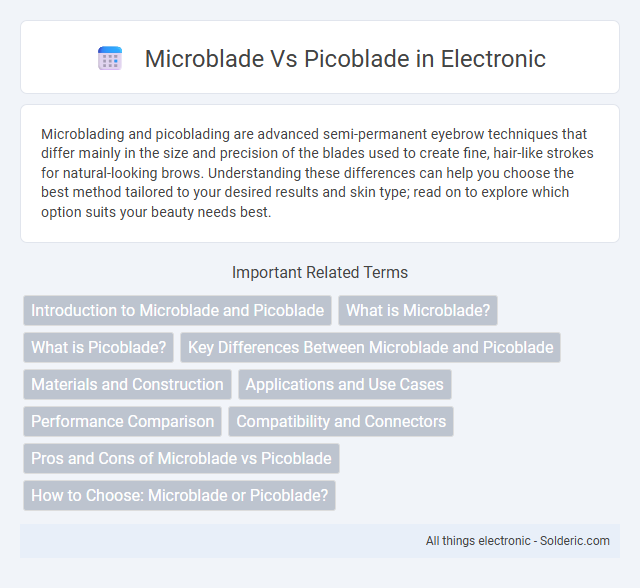Microblading and picoblading are advanced semi-permanent eyebrow techniques that differ mainly in the size and precision of the blades used to create fine, hair-like strokes for natural-looking brows. Understanding these differences can help you choose the best method tailored to your desired results and skin type; read on to explore which option suits your beauty needs best.
Comparison Table
| Feature | Microblade | Picoblade |
|---|---|---|
| Blade Size | Standard microneedle blades (0.2-0.3 mm) | Ultra-fine piconeedle blades (0.15-0.2 mm) |
| Precision | High precision for hair-like strokes | Enhanced precision for finer, detailed strokes |
| Pain Level | Moderate discomfort | Minimal discomfort due to smaller needles |
| Healing Time | 7-10 days | 5-7 days |
| Use Case | Eyebrow shading and microstroking | Fine detailing and sensitive skin areas |
| Durability | Standard blade lifespan | Higher blade durability with less wear |
| Ideal for | Clients seeking natural, fuller brows | Clients requiring ultra-fine, subtle enhancements |
Introduction to Microblade and Picoblade
Microblade and Picoblade are advanced techniques used in cosmetic tattooing to create natural-looking hair strokes for eyebrow enhancement. Microblade employs a manual handheld tool with fine needles to deposit pigment into the skin's epidermis, while Picoblade utilizes a digital machine providing more precise pigment placement and longer-lasting results. Both methods aim to achieve realistic, semi-permanent eyebrow improvements but differ in application technique and durability.
What is Microblade?
Microblade is a semi-permanent eyebrow tattoo technique that uses a fine blade to create hair-like strokes, giving a natural and fuller look to sparse or thin eyebrows. The procedure deposits pigment into the superficial layers of the skin, ensuring results that typically last 12 to 18 months before requiring touch-ups. Microblade pigments are designed to fade gradually and blend with the natural eyebrow hairs, making it a popular choice for those seeking subtle enhancement.
What is Picoblade?
Picoblade is an advanced microblading technique that uses ultra-fine needles to create more precise, natural-looking hair strokes for eyebrow enhancement. Compared to traditional microblading, Picoblade implants pigment more delicately into the skin, resulting in finer details and longer-lasting results. Suitable for those seeking subtle, realistic eyebrow definition, Picoblade minimizes skin trauma and promotes faster healing.
Key Differences Between Microblade and Picoblade
Microblade and Picoblade techniques differ primarily in blade size and precision, with Microblade employing slightly larger, traditional blades for natural-looking hair strokes, while Picoblade uses ultra-fine needles allowing for more detailed and delicate strokes. The healing time for Picoblade is generally faster due to its less invasive approach compared to Microblade. Pigment retention and longevity can vary, with Picoblade offering more vibrant, longer-lasting results due to its precise pigment placement.
Materials and Construction
Microblade tattoo needles are typically crafted from high-quality stainless steel with fine, closely grouped needles designed for precision and durability. Picoblade needles utilize ultra-fine stainless steel with enhanced flexibility, allowing for more delicate and detailed work, often favored for intricate cosmetic applications. Both needle types undergo rigorous manufacturing processes to ensure consistent sharpness and minimize skin trauma during procedures.
Applications and Use Cases
Microblade technology excels in precise cosmetic procedures such as eyebrow microblading, offering detailed hair-like strokes for natural-looking enhancements. Picoblade, with its ultra-fine needle configuration, is ideal for delicate skin treatments and targeted pigmentation, providing minimal invasion and faster healing. Both tools serve specialized roles in permanent makeup and dermatological therapies, with Microblade favored for bold strokes and Picoblade for subtle, refined results.
Performance Comparison
Microblade offers superior cutting precision with its larger blade size, making it ideal for heavy-duty tasks and faster material removal, while Picoblade excels in detailed, fine work due to its much smaller blade that provides greater control and less surface damage. In terms of speed, Microblade achieves higher efficiency in large-scale projects, whereas Picoblade prioritizes accuracy over rapid cutting, suitable for intricate designs and delicate materials. Performance benchmarks indicate Microblade can reduce operation time by up to 40% on thick substrates, while Picoblade improves edge quality by 30% on detailed patterns.
Compatibility and Connectors
Microblade connectors typically use an edge card interface designed for high-density applications, offering compatibility with standard PCB slots but requiring precise alignment. Picoblade connectors feature a smaller pitch and a push-pull locking mechanism, making them compatible with compact designs and ensuring secure connections in tight spaces. Your choice depends on the device's size constraints and the need for a reliable, easy-to-manage connector system.
Pros and Cons of Microblade vs Picoblade
Microblade offers precise, natural-looking hair strokes ideal for those seeking semi-permanent eyebrow enhancement but can cause more skin trauma and has a shorter lasting effect compared to other methods. Picoblade utilizes ultra-fine needles with advanced technology, resulting in less skin damage, longer-lasting results, and faster healing, though it typically requires higher investment and specialized technician skills. Both techniques vary in durability, pain level, and cost efficiency, with Microblade favoring beginners and budget-conscious clients, while Picoblade suits those desiring finer detail and longevity.
How to Choose: Microblade or Picoblade?
Choosing between Microblade and Picoblade depends on your desired eyebrow look and skin type. Microblade creates natural, hair-like strokes ideal for those with normal to oily skin, while Picoblade uses finer needles for more detailed, precise lines suited for sensitive or dry skin. Your decision should consider the longevity you want and the level of detail that matches your eyebrow goals.
Microblade vs Picoblade Infographic

 solderic.com
solderic.com